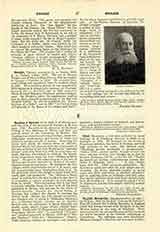

Dwight, THOMAS, anatomist, b. at Boston, 1843; d. at Nahant, September 8, 1911. The son of Thomas Dwight and of Mary Collins Warren, with his mother he became a Catholic in 1856. He attended Harvard College and graduated from its medical school in 1867. After studying abroad, he was appointed in 1872 instructor in comparative anatomy at Harvard, lectured also at Bowdoin, and in 1883 succeeded Oliver Wendell Holmes as Parkman professor of anatomy. Dr. Dwight’s talent for organization enabled him to effect a needed reconstruction of the Harvard Medical School. In 1872 he published his “Frozen Sections of a Child”, and in 1907 “A Clinical Atlas of Variations of the Bones of the Hands and Feet”.
He was also a frequent contributor to scientific journals. In the Warren Museum of Anatomy Dr. Dwight arranged a section of osteology which is considered the best in existence, and he enjoyed an international reputation as an anatomist. Long a zealous member of a conference of St. Vincent de Paul, he died president of the central council. In 1883 Dr. Dwight married Miss Sarah C. Iasigi of Boston and eight children were born to them. His “Thoughts of a Catholic Anatomist” (New York, 1911) is a valuable work of Christian apologetics, for neither in his life nor in his writings had Dr. Dwight any difficulty in reconciling faith and science.
WALTER DWIGHT

